Some of Britain’s best houses and castles are in Scotland, with their own distinctive character, impressive architecture and fascinating interiors. We take a look inside seven of the finest…
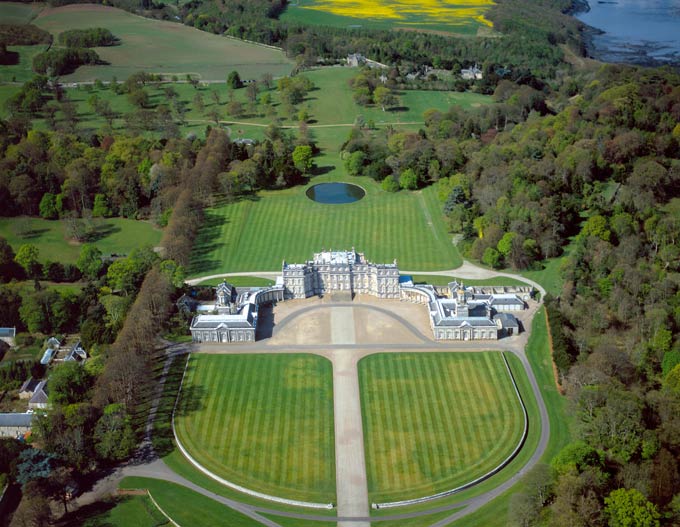
With its rich history and myriad powerful families it is no surprise that Scotland enjoys a wealth of stately homes – palatial abodes each with their own intoxicating stories to tell. These days many are open to the public and most now make a real effort to offer visitors a rewarding experience, so there has never been a better time to explore.
Just on the fringes of Edinburgh in the riverside suburb of South Queensferry lies an old dame that rears up as grandly from its manicured gardens as any great house in Britain. Hopetoun House has reclined by the banks of the Firth of Forth for over 300 years and today is at the heart of a 6,500 acre estate with a farm shop, holiday lets and myriad events, from horse trials through the Guy Fawkes Night bonfires.
Affectionately known as the ‘Scottish Versailles’, it was commissioned by Charles Hope (later the 1st Earl of Hopetoun) and stands as one of Britain’s finest 18th-century stately homes. Sir William Bruce built the original house in 1699, completing his work in 1707. But it is the work of one of Scotland’s greatest ever architects – William Adam – that is most striking. In 1721 Adam was tasked with remodelling and enlarging Hopetoun and such was the brilliance of his work that the twin colonnaded wings he added still look seamless.
Sweep up the grand steps and the interior is equally breathtaking. It was completed by Adam’s sons, John and Robert, after his death. The styles you see today are mainly late Georgian through to Edwardian, but the house is also full of treasures amassed by one of Scotland’s most illustrious families over several centuries. Ornate period furniture laces the interior as does a rich treasure of paintings, tapestries and vintage clocks, with the rooms a riot of elegant carving, gilding and plasterwork. Many a luminary has dined in Hopetoun’s lavish dining room, including King George IV, who visited in 1822 and is said to have enjoyed ‘turtle soup and three glasses of wine’.
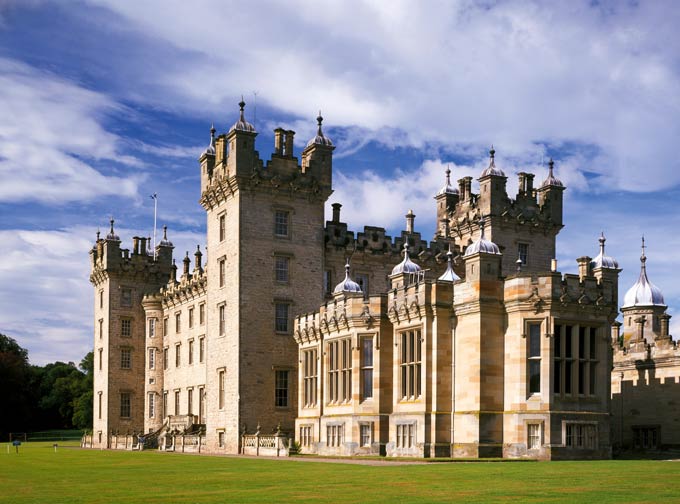
To the south in the Borders, Floors Castle stands proud as the glorious seat of the mighty Dukes of Roxburghe. Today this progressive estate boasts a golf course, luxury hotel, farm shop and restaurant, as well as one of the grandest stately homes in Scotland. It sits on an idyllic spot on a natural terrace dominating the River Tweed and gazing out towards the Cheviot Hills.
Floors Castle’s history reads like a who’s who of Scottish stately home architecture. William Adam was commissioned to build the house in 1721 by the first duke and he carved a relatively simple, symmetrical and elegant Georgian design. Much of what you admire today, though, comes courtesy of William Playfair. The most fashionable architect of his day, a man who also left his indelible mark on Edinburgh’s UNESCO World Heritage listed New Town, refashioned the castle between 1837 and 1847, adding a much more dreamy fairy-tale appearance awash with pinnacles and cupolas.
It wasn’t an outside talent, though, we have to thank for the grandeur of the interior. Much of the fine furniture, tapestries and artwork come courtesy of the 8th Duchess, May Goelet, an American heiress. Duchess May amassed a collection that includes everything from 15th-century tapestry right through to 20th-century post-impressionist artwork by the likes of such luminaries as Henri Matisse. The Gobelins tapestries that you can see today at Floors came from her Long Island home.
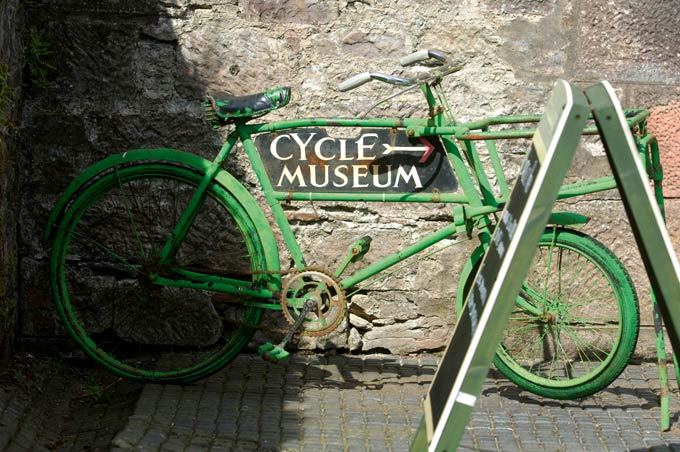
Crossing to the west Drumlanrig Castle in Dumfries and Galloway is an ancient Douglas stronghold and the Dumfriesshire home of the Duke and Duchess of Buccleuch and Queensberry. As well as the landmark castle, the 90,000-acre estate boasts a country park, Victorian gardens and mountain bike trails. Land Rover safaris and ranger-led walks further open up the estate, while a woodland adventure playground is on hand for younger thrill seekers. More sedentary souls can enjoy the castle shop and the tearoom serving estate-reared meat and Drumlanrig herbs, while the Scottish Cycle Museum is housed in the Stableyard.
Drumlanrig Castle is a striking pink sandstone edifice, replete with 120 rooms, 17 turrets and four towers, that dominates the Nith Valley. It was commissioned in 1691 by William Douglas, the first Duke of Queensberry, and this spectacular creation remains one of the country’s finest renaissance buildings. Somewhat unusually, the building is woven around an open courtyard with a circular staircase tower in each corner.
The highlight inside is the Buccleuch Art Collection. Here you can uncover such world-famous treasures as Rembrandt’s An Old Woman Reading and Leonardo da Vinci’s Madonna of the Yarnwinder, the latter now back in pride of place after being stolen in 2003. Other attractions in this priceless collection include works by Hans Holbein, Bartolomé Esteban Murillo and Sir Anthony van Dyck. Grand reception rooms and magnificent staircases, laced with more fine paintings, tapestries and objets d’art, complete an unforgettable cocktail.
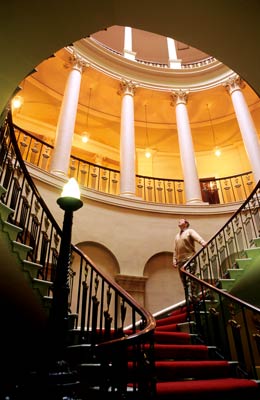
A little to the northwest in Ayrshire is another of Scotland’s best-loved stately homes, Culzean Castle (pronounced kulain), which enjoys a stunning clifftop setting overlooking the Atlantic Ocean. The graceful grounds are awash with exotic flora, shady woodland trails and quiet ponds. An adventure playground is also on hand for children, with plenty of eating and drinking options too. Another highlight is the coastal trails, which open up the coastline and offer sweeping views out towards the rock hulk of Ailsa Craig.
The first records of Culzean Castle proper are from the 1590s when Sir Thomas Kennedy began enlarging the original tower house. It was not until the 18th century though that the mighty Kennedys transformed Culzean into today’s neoclassical mansion, with Robert Adam one of the seminal talents who helped weave one of Britain’s finest stately homes.
Inside you will discover what is perhaps, after Windsor Castle, the largest armoury collection of its type in Britain. Much of it was amassed in 1812 when the 12th Earl bought the pistols and swords from the Office of Ordnance at the Tower of London. The library is one of the architectural highlights. Although remodelled during Victorian times Adam’s neoclassical grace has been carefully preserved with the signature motifs and fruit and vines echoing the room’s original function as a dining room. The Oval Staircase is, though, Adam’s masterpiece, which seamlessly weaves together the castle’s myriad styles.
Out west in Argyll, Scotland’s World Cup Elephant Polo winning captain, the Duke of Argyll, is at the head of a remarkable stately home, Inveraray Castle, and a remarkable estate that plays an active role in the local community. The sprawling estate offers hunting and fishing, as well as holiday lets, while the castle boasts immaculate gardens, a tearoom and a gift shop where you just might chance upon the hands-on duke and his wife serving customers.
Inveraray Castle has presided over Scotland’s longest sea loch, Loch Fyne, since the 1400s. The current incarnation was inspired by a Vanbrugh (the architect of Blenheim Palace) sketch. The 2nd duke had the foundation stone laid in 1746, employing architects Roger Morris and William Adam to create an orgy of baroque, Palladian and Gothic, which would not look out of place in the Louvre. William Adam never lived to see its completion, but his sons, John and Robert, finally finished it 43 years later. A third floor and the conical roofs on the corner towers were added after a serious fire in 1877.
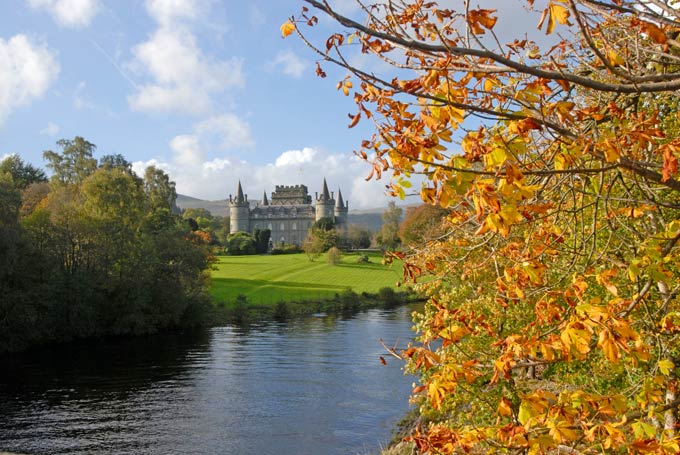
Entering into Inveraray Castle is a breathtaking experience. On the ground floor is the State Dining Room, decorated by an elaborate painting dating from 1784 by French artists Girard and Guinard, whose work only survives at Inveraray. Then there are the Beauvais tapestries in the Tapestry Drawing Room and the unique 21m high Armoury Hall. Look out for everything from roundels of Brown Bess muskets dating from around 1740, through to Scottish broadswords from the time of Queen Victoria’s first visit to Inveraray in 1847 and a sporran worn by Rob Roy.
Venturing into the Highlands another grand stately home awaits. Blair Castle in Perthshire is the ancient seat of the Dukes of Atholl. It is home to the only legal private army in Europe, the Atholl Highlanders. The massive surrounding estate offers walking trails, Land Rover safaris, horse riding and hiking among other active pursuits, and has an array of accommodation, from wooden chalets to cottages.
The first castle is said to have been built by John I Comyn, Lord of Badenoch in the 13th century. Soon after the title Duke of Atholl was granted to the 2nd Marquess in 1703 the castle showed it was no mere stately home by withstanding a Jacobite siege. The present day appearance owes much to David Bryce, who reworked the building in Scots Baronial style in the 19th century and added the grand ballroom. In March 2011 fire struck the clock tower, causing its roof and second floor to collapse into the first floor. An impressive restoration was completed this year.
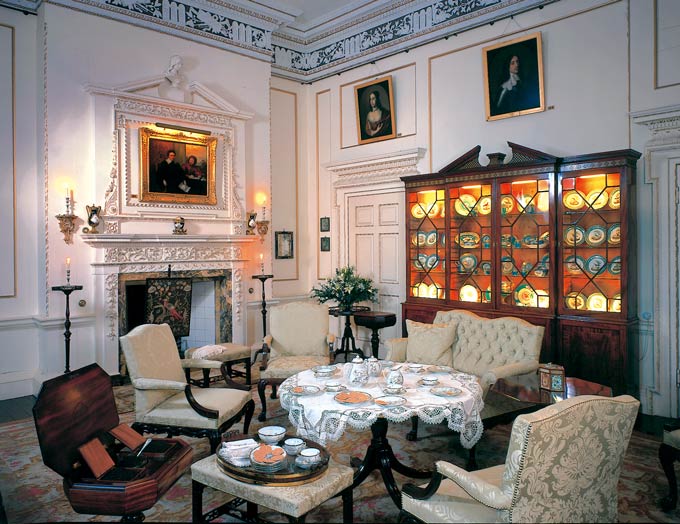
In 1936, Blair Castle was one of the first stately homes to open to the public. Treasures to savour include a range of weapons, hunting trophies, paintings, furniture, and needlework amassed by the Murray family. Chillingly, the armoury houses muskets used in anger at the Battle of Culloden in 1746. The Picture Staircase meanwhile features a comprehensive family portrait gallery, completed in 1756 as part of Georgian remodelling. The walls appear to be panelled, but if you look closer you can see they are actually superb plasterwork by Edinburgh stuccoist Thomas Clayton. Queen Victoria stayed in the Derby Suite in 1844 and must have been impressed as she then granted the right of the Atholl Highlanders to bear arms.
Moving across to the isles, Mount Stuart is a fittingly grand finale to a tour of Scotland’s stately homes. It was built by the world’s richest man at a time when Scotland was the second richest country in the world. Today it dominates the Isle of Bute and is arguably the finest building in the Scottish isles. It is at the heart of a much larger estate, which these days offers a range of ornate gardens, a restaurant serving island produce, garden centre, adventure playground and numerous walking trails.
A grand house had long stood on this scenic spot overlooking the Firth of Clyde before a devastating fire in 1877. Today’s house is one of the most outstanding Gothic Revival buildings in the UK, the ambitious vision of the 3rd Marquess of Bute. Commissioned almost immediately after the fire, Mount Stuart finally opened in 1912 using architect Sir Robert Rowand Anderson’s impressive Victorian designs. The house had fallen into neglect before the 1980s when the 6th Marquess set about restoring its glory.
Lord Bute sadly never the saw the completion of his impressive overhaul. The beauty is that the marble-rich interior still shines with the works of some of the finest craftsmen of the Victorian age, including sculptor Thomas Nicholls and architect William Frame, but new works have also been seamlessly added, such as the decoration of the chapel lantern by Tom Errington and etched glass windows by Alison Kinnaird. Like all of Scotland’s grandest stately homes Mount Stuart may be blessed with both a rich heritage and a sublime beauty, but visit and you will find that it also certainly does not sit on its laurels.


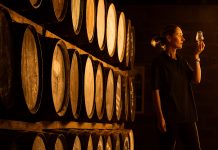


 © 2024
© 2024